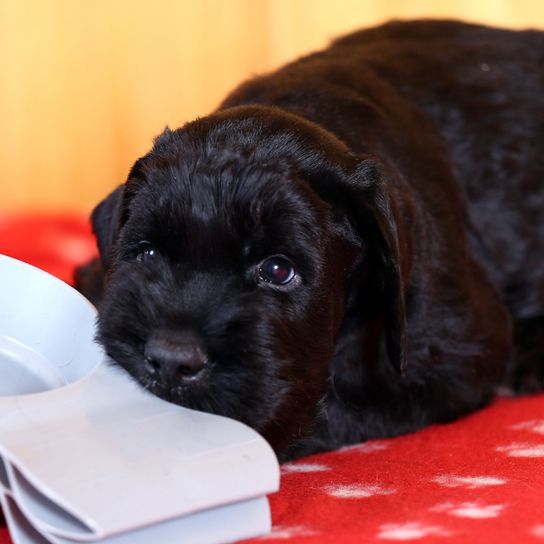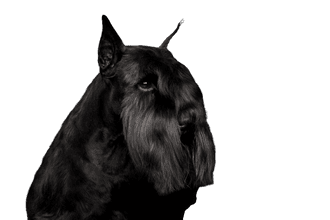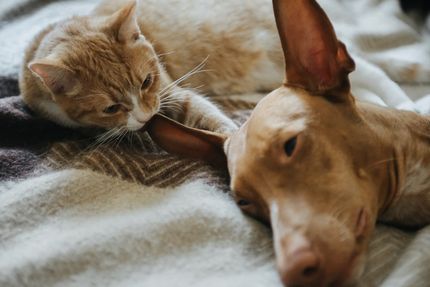Facts & Origin
Origin and history of the Giant Schnauzer
Schnauzers used to be seen all over Central Europe accompanying carriages. They followed their owners for countless kilometers through the countryside, making sure that nothing of their belongings was stolen along the way. In the evening, when the horses were unharnessed in the stable, the tireless dogs worked as rat and mouse catchers. In addition, the ancestors of the breed were used as herding dogs for large herds of cattle. However, it is not completely clear which cross-breeding actually took place: there is often a discussion about the possible relationship of the Schnauzer, the Great Dane, the Bouvier des Flandres, but also others.
The four-legged dog owes its nickname "Bierschnauzer" to its activity in southern Germany in the 19th century. At that time, he was namely in and around Munich with brewers on the road, who delivered their beer by carriage customers. It was also in the Bavarian capital that Giant Schnauzers were first seen at a dog show in 1909. Four years later, the studbook for the breed was created. Since the Giant Schnauzer was discovered as a military dog during World War I, he has proven himself as a rescue and police dog. Since 1925, he has been officially considered a service dog breed. In the 1930s, he was still the most popular among the Schnauzer breeds, but was replaced by the Miniature Schnauzer after World War II.
Characteristic feature
Typical and eponymous for this breed is its distinctive moustache, but also the bushy brows. This gives the Giant Schnauzer his characteristic, confident expression. Bred this characteristic because the beards serve as protection from rodents or the rough terrain.
Suitability and attitude
This athletic dog breed is suitable as a sporting or working dog. If you are looking to purchase a Giant Schnauzer, it is best to be athletic. Whether used as a guard, rescue, or police dog, or for a variety of dog sports, it must first be given enough exercise to feel comfortable.




| Alternate Name | - |
| Origin | Germany |
| Life expectancy | 12 - 15 years |
| Care requirements | high-maintenance |
| Activity level | high |
| FCI group | Pinscher and Schnauzer type |
| AKC group | not recognised |
| KC group | not recognised |
Giant Schnauzer mixes
Attitude, character and temperament of the breed
Typical traits of the Giant Schnauzer
Typical traits are his benign, balanced character and incorruptible loyalty to the master. He possesses highly developed sense organs, cleverness, trainability, strength, endurance, speed and resistance to weather and diseases. The breed usually has a hunting instinct.
Constantly the Giant Schnauzer is in search of employment. When playing, he is not squeamish, he may even bump into you. This is one reason why he is less suitable as a playmate for small children. For older children, however, he is a devoted and good-natured playmate. The prerequisite is expert training, which is best started with the Giant Schnauzer puppy.
It is especially important for a dog in this format to work on leash-handling skills early on. The Giant Schnauzer needs confident leadership and clear rules to guide him. Then he becomes a reliable companion who willingly submits.

Typical breed diseases of the Giant Schnauzer.
Some diseases occur more frequently in the Giant Schnauzer, these include:
- Hip joint dysplasia
- Elbow dysplasia
- Bone tumors
- Cancers
To prevent joint problems, you should always feed age-appropriate food. Particularly in puppyhood, a very nutrient-dense food can lead to rapid growth, which stresses the musculoskeletal system and thus promotes joint disease. Also, make sure that your pet maintains its ideal weight.
Giant Schnauzer breeding and purchase
Since its foundation in 1914, the Austrian Schnauzer Pinscher Club has been committed to maintaining breed standards. If you buy a Giant Schnauzer from a breeder registered with the club, you can be sure that the parents are healthy and strong.
It would also be a good deed if a Giant Schnauzer in need moves in with you. For this, it is best to inquire at animal shelters in your area or animal welfare organizations.


Breed characteristics of the Giant Schnauzer
The Giant Schnauzer is classified by the FCI as Group 2 (Pinscher and Schnauzer - Molossoid - Swiss Mountain and Cattle Dogs), Section 1 (Pinscher and Schnauzer). The breed standard requires a working test.
The Giant Schnauzer usually grows to a height of 60-70 cm and reaches a weight of 35 to 47 kg.
The gait
The gait of this dog breed is elastic, elegant, agile, free and roomy. The forelegs swing forward as far as possible, the hindquarters give - reaching out and springing - the necessary thrust. The foreleg of one side and the hindleg of the other side are led forward at the same time. Back, ligaments and joints are firm.
The head
The strong skull is elongated, without a strongly protruding occiput, but with a distinct stop marked by the brows. The head should match the vigor of the dog. The forehead is flat and runs wrinkle-free and parallel to the bridge of the nose.
The muzzle
The nose leather is well developed, with large openings and always black. It sits on a muzzle that has a straight nasal bridge and ends in a blunt wedge. The black, smooth lips lie smoothly against the jaws with closed lip angles.
Typical of this breed is a complete scissor bite, which should be strongly developed, well closing and pure white. The chewing muscles are strongly developed, but no too strongly developed cheek formation should disturb the rectangular head shape (with beard).
The eyes & ears
The oval, dark, medium sized eyes are directed forward with a lively expression. The eyelids should be well fitted.
The Giant Schnauzer also has high set, V-shaped folding ears, the inner edges of which should lie close to the cheeks and carried evenly, turned forward towards the temples, with the parallel folding not overhanging the top of the head.
The torso
The strong, muscular neck of the Giant Schnauzer is arched in a raised manner. The neck blends harmoniously into the withers and is strongly set on, slender, nobly curved and in keeping with the dog's stature. The skin of the throat lies taut and without folds. Starting from the withers, which form the highest point, the upper profile line appears to slope slightly backwards and leads over a strong, short and tight back and equally short, strong but deep loins.The distance from the last rib to the hip is short, so that the dog appears compact. The curppe runs in a slight curve and thus merges imperceptibly into the base of the tail.
The chest of this dog breed is moderately broad, oval in cross-section and reaches to the elbows. The forechest is markedly developed by the tip of the sternum. Since the flanks should not be excessively tucked up, the lower profile line forms a nicely curved line with the underside of the rib cage.
The tail
Natural, the breeding goal of the Giant Schnauzer is the sabre or sickle tail.
The limbs
The forelegs, seen from the front, are stocky, straight and not close set. The shoulder blade lies firmly against the rib cage, is well muscled on both sides of the shoulder blade bones and projects above the spinous processes of the thoracic vertebrae. As oblique as possible and well laid back, the angle to the horizontal is about 50°. The upper arm, also well attached to the torso, should be strong and muscular with an angle to the scapula of about 95° to 105° and continuing into a well fitting elbow that is neither turned out nor in. The forearm, on the other hand, seen from all sides, is perfectly straight, strongly developed and well muscled. The stable carpometacarpal joint is strong but stands out only slightly from the structure of the forearm. The pastern, seen from the front, is vertical, seen from the side, slightly sloping to the ground, but always strong and slightly springy.
Seen from the side, the hindquarters are sloping, seen from behind they are parallel, but not narrowly set. The only moderately long thigh is broad and strongly muscled, the stifle joint turned neither in nor out. This is followed by the long, strong and sinewy lower thigh, which merges into a powerful, distinctly angulated and stable hock joint. It must be directed neither inwards nor outwards. The short rear metatarsus is perpendicular to the ground.
The paws of the Giant Schnauzer are short and round with tightly knit, well arched toes (so-called "cat feet") and short, dark nails and coarse pads.
The coat
The skin, which is close-fitting all over the body, is covered with wiry and dense hair. It consists of a dense undercoat and the top coat, which is by no means too short, but hard and lying close to the body. The top coat is coarse, long enough to check its texture, but neither shaggy nor wavy. The hair on the legs tends to be not quite so harsh. On the forehead and ears it is short. As a typical characteristic it forms at the muzzle the not too soft beard and the bushy brows, which slightly overshadow the eyes.
In terms of color, the Giant Schnauzer can be found in pure black (with black undercoat), "pepper salt" or black and silver.
The breeding goal for the peppersalz is a medium shade with evenly distributed, well pigmented peppering and gray undercoat. Allowed are the color shades from dark iron-gray to silver-gray. All colors must have a dark mask underlining the expression, which should harmoniously match the respective color. Distinct light markings on the head, chest and legs are undesirable.
For the black and silver color, the breeding objective is black top coat with black undercoat as well as white markings above the eyes, on the cheeks, on the beard, on the throat, on the front of the chest two divided triangles, on the middle foot of the front legs, on the paws, on the inside of the hind legs and on the anus. The forehead, nape and outer sides of the ears should be black, like the top coat.
| Fur length | short |
| Fur | rough-haired |
| Ear shape | Tilt-ear |
| Tail | lang |
| Anatomy | sporty |
| Size ♀ | 60 - 65 cm |
| Weight ♀ | 27 - 48 kg |
| Size ♂ | 65 - 70 cm |
| Weight ♂ | 25 - 34 kg |
| Suitable For | Blind people |
Colors



Known Diseases
Cancer
May be common in older dogs.
FAQ
-
The Giant Schnauzer is in principle a companion dog and service dog. The breed is therefore also suitable as a family dog.
-
Yes, Schnauzers have a hunting instinct and are considered a hunting dog breed.
-
No, a giant schnauzer is not considered a dangerous or even aggressive dog breed.
-
A giant schnauzer costs about 1500 euros.
-
Bred the beard in the Schnauzers, as they serve as protection from rodents or the rough terrain.
-
Yes, the Giant Schnauzer is popular for Schutzhund training.
-
Giant schnauzers usually grow 60-70 cm tall.
-
Yes, Giant Schnauzers have a jadgtrieb due to their breed.
























